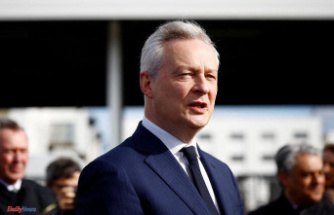The decision has finally been made: With the F-35, the German Air Force is getting a new fighter plane. Why the jet is so important but still controversial - questions and answers about the most modern combat aircraft in the world.
Why does Germany need a new fighter jet?
This has to do with the Tornado, the fighter jet that represents the German Air Force like no other aircraft. She has been flying it for 40 years. The first jets were delivered to the Bundeswehr in 1981. Anyone who still remembers the technical level of cars that drove on the roads in 1981 can understand that military experts have been pushing for many years to replace the Tornado with a modern fighter plane.
Although the Bundeswehr jet was constantly and extensively retrofitted and modernized, an old model is no longer a stealth jet. Now its successor has been determined: the F-35 from the American manufacturer Lockheed Martin. The budget committee of the Bundestag approved the first tranche for the payment of 35 airmen on Wednesday afternoon. The total costs are estimated at around ten billion euros. Of course, parliament still has to approve the purchase, but the committees, which include members of parliament from all parties, make a preliminary decision. With that, the purchase of the F-35 is almost a done deal, and a decision that has been postponed from one legislature to the next for decades has finally been made.
Why was the deal on the brink at short notice?
Federal Defense Minister Christine Lambrecht announced in March 2022 that she wanted to purchase the F-35. A few days before the committees' decision, however, a paper was made public in which their ministry questioned its own decision. Several risk factors are listed there, including the necessary conversion of airfields for the F-35, the US seller's high security requirements and possible technical problems with the approval of the fighter jets for flight operations in Germany.
Even experts do not deny that all these hurdles have to be overcome. However, it would be difficult to understand that a decision in favor of an Air Force fighter jet, which had been due for decades, could be called into question again because some airfields would have to be converted for it.
Among experts, however, the reference to problems with the approval of the jet for German airspace caused frowns. Because the machine is already approved by many European neighbors. "Problems with the F-35? Germany is looking for problems where the Netherlands, Norway, Belgium, Italy and other European nations see none," wrote Air Force Inspector Ingo Gerhartz on Twitter. And finally asked: "Is the air there different?"
Will the F-35 bring about a turning point?
Clear no. The decision for the Tornado successor was overdue. It is true that the money for the F-35 comes from the 100 billion special fund that is intended to help finance the turning point in the Bundeswehr, and in his turning point speech at the end of February Chancellor Olaf Scholz indicated for the first time that the successor decision might be in favor of the F- 35 would fall. But this purchase only fills a capability gap that has existed for many years by the Department of Defense. The Bundeswehr doesn't really get ahead of the situation.
What can the F-35 do?
This fighter jet is the most modern model that is currently available worldwide. First of all, it has the best stealth properties, i.e. technology that makes it difficult to locate the plane. "We need this lower radar signature and the ability to detect and engage targets from a great distance," security expert Rafael Loss from the European Council on Foreign Relations (ECFR) told DW. "The F-35 can do that better than any other air combat system currently on the market."
The pilot's helmet alone costs more than $400,000. It offers an internal display on which camera images can be transmitted live. The pilot looks through the aircraft as if with X-ray eyes. The weapons are controlled by eye movements.
However, a lot of very sensitive technology on board also makes the multi-role combat aircraft susceptible to malfunctions - one of the main criticisms of the machine, alongside the problem that the F-35 variant that the Bundeswehr wants to purchase has not yet reached series maturity. Full completion of the further development of this variant is not expected before 2029. In a report from April this year, the US Court of Auditors identified 826 defects in the F-35. Communication and navigation, cyber security and target acquisition are said to be affected. Problems in software development are seen as the cause of many difficulties. How far the development has progressed when the first jets are delivered to the Air Force can hardly be predicted at the moment.
A big advantage of the fighter jet is its distribution in Europe. The Italian, British, Dutch and Norwegian military, among others, fly F-35s. Switzerland and Finland also rely on the US plane. This will make cooperation between the German Air Force and the European partners mentioned much easier in the future.
How will the F-35 be used?
The Ministry of Defense sets the framework for the future tasks of the fighter jet very narrowly. It is intended to secure Germany's nuclear participation, i.e. to be able, in an emergency, to bring the 20 American atomic bombs stored in the Bundeswehr air base in Büchel in southern Germany to an enemy target. For this task in particular, the aviator's stealth technology is a decisive advantage over the old Tornado.
It has long been doubtful whether the tornado would be able to reach its target in combat without first being located and attacked by enemy air defense. This is another reason why it was problematic that the decision on his successor was delayed for many years, especially by the grand coalition.
Because the deterrent effect of the 20 nuclear weapons in Germany became implausible to the extent that the Tornado as a carrier jet was getting on in years. However, the threat of a retaliatory strike, which the opponent would be able to fend off well in an emergency, is not effective. In terms of nuclear sharing, the F-35 is therefore the first choice. Their capabilities bring credibility back to the deterrence goal behind nuclear sharing.
Is nuclear sharing necessary at all?
This question is evaluated very differently. A central argument against the 20 atomic bombs in Büchel and Germany's promised willingness to use them in a retaliatory attack in the event of a nuclear attack is the lack of benefit for Germany. "On the contrary," says Inga Blum from the NGO International Doctors for the Prevention of Nuclear War. Nuclear participation is "a security risk. The nuclear weapons in Germany would be the first target in the event of war and would not be available for a so-called 'retaliatory strike'." The planned billion-euro investment in the F-35 therefore contradicts "the fundamental security interests of the population," said Blum.
However, the opponents of nuclear sharing fail to propose a solution as to how Germany could contribute to NATO's defense strategy to an appropriate extent. The alliance is based on the idea of sharing burdens and risks. The United States is also spreading its nuclear umbrella over Europe as a deterrent, but in return expects European countries to be willing to shoulder other burdens and risks.
If Germany were to end its nuclear participation in the NATO deterrence strategy, this gap in the conventional area would have to be closed at great financial expense. "Theoretically, from this point onwards, we would have to spend a multiple on conventional armaments," says Frank Sauer, security expert at the Bundeswehr University in Munich. "Only in this way could we as the Federal Republic of Germany, with a view to reinsuring Central and Eastern Europe, provide sufficient capabilities to compensate for the termination of nuclear sharing."
For comparison: Up until now, NATO member Germany has never managed to budget two percent of its economic output for armaments expenditures. The NATO partners agreed on this share of the gross domestic product a few years ago. In order not to risk a lasting conflict in the alliance, Germany would have to significantly increase its annual armaments budget without nuclear sharing.












